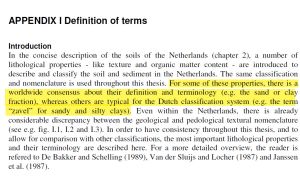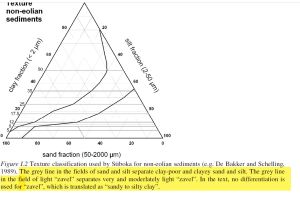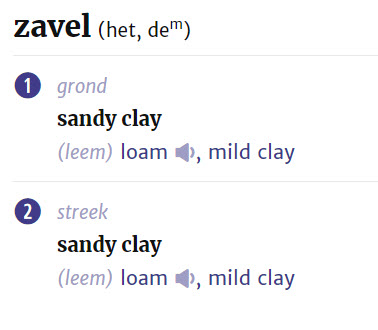No edit summary |
No edit summary |
||
| Line 28: | Line 28: | ||
• kleiig zand - clayey sand | • kleiig zand - clayey sand | ||
• silt - silt | • silt - silt | ||
• zeer lichte zavel - very light 'zavel' | • '''zeer lichte zavel''' - very light 'zavel' | ||
• matig lichte zavel - moderately light 'zavel' | • '''matig lichte zavel''' - moderately light 'zavel' | ||
• zware zavel - heavy 'zavel' | • '''zware zavel''' - heavy 'zavel' | ||
• lichte klei - light clay | • lichte klei - light clay | ||
• matig zware klei - moderately heavy clay | • matig zware klei - moderately heavy clay | ||
Revision as of 12:54, 1 December 2023
IATE: lichte zavel (lemig zand, leemzand, lemige zandgrond, siltig zand, kleiig zand) = loamy sand, loamy sand soil zware zavel (zandige lichte klei) = sandy clay loam (https://iate.europa.eu/search/result/1701281353597/1)
Most soils clearly belong to two different universa, and as a consequence there are two classification triangles, one for aeolean and one for the other sediments, with an overlap in the sand corner (Figs. 14 and 15, see also 'Bijlage' Ic).
Approximate translation of the terms:
Nomenclature of the aeolean classes:
• leemarm zand - loam-poor sand
• zwak lemig zand - slightly loamy sand
• sterk lemig zand - very loamy sand
• zeer sterk lemig zand - extremely loamy sand
• zandige leem - sandy loam
• siltige leem - silty loam
• kleiige leem - clayey loam
Nomenclature of the nonaeolean classes:
• kleiarm zand - clay-poor sand
• kleiig zand - clayey sand
• silt - silt
• zeer lichte zavel - very light 'zavel'
• matig lichte zavel - moderately light 'zavel'
• zware zavel - heavy 'zavel'
• lichte klei - light clay
• matig zware klei - moderately heavy clay
• zeer zware klei - very heavy clay
("Systeem van bodemclassificatie voor Nederland: de hogere niveaus", 1966)



Dutch
- zavel
English
- coarse sand (GWIT)
- sandy clay (Van Dale)
- sand (finely ground rock)[1]
- (chiefly Southern) sand (Wiktionary)
- soil consisting mostly of sand with significant to high levels of clay (Wiktionary)
- sandy clay [Dutch source term: zavel]
Van Dale
References
- https://en.wiktionary.org/wiki/zavel
- https://dspace.library.uu.nl/bitstream/1874/13275/24/app1.pdf (the thumbnail images on this page are from this document)
- https://london-brussels.blogspot.com/2009/05/place-du-petit-sablon.html (The name “sablon” refers to the yellowish earth layer that could be seen along the shoulders of the dirt roads. This type of sandy clay was called "zavel" in Dutch and "sablon" in French. In the 14th century a small chapel in the sablon area was transformed into an important pilgrimage site where a miraculous statue of Our Lady was venerated.)
